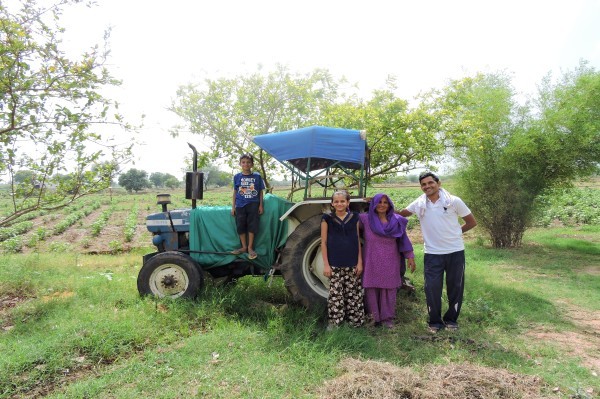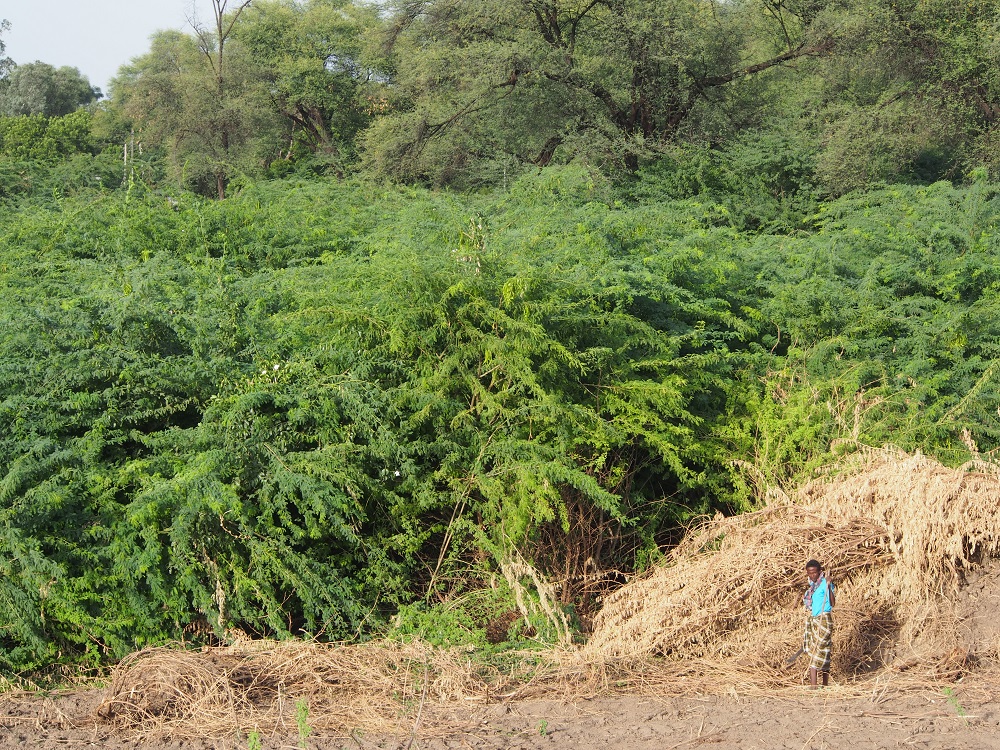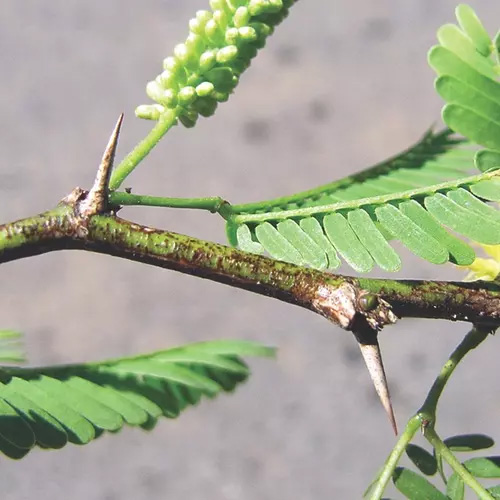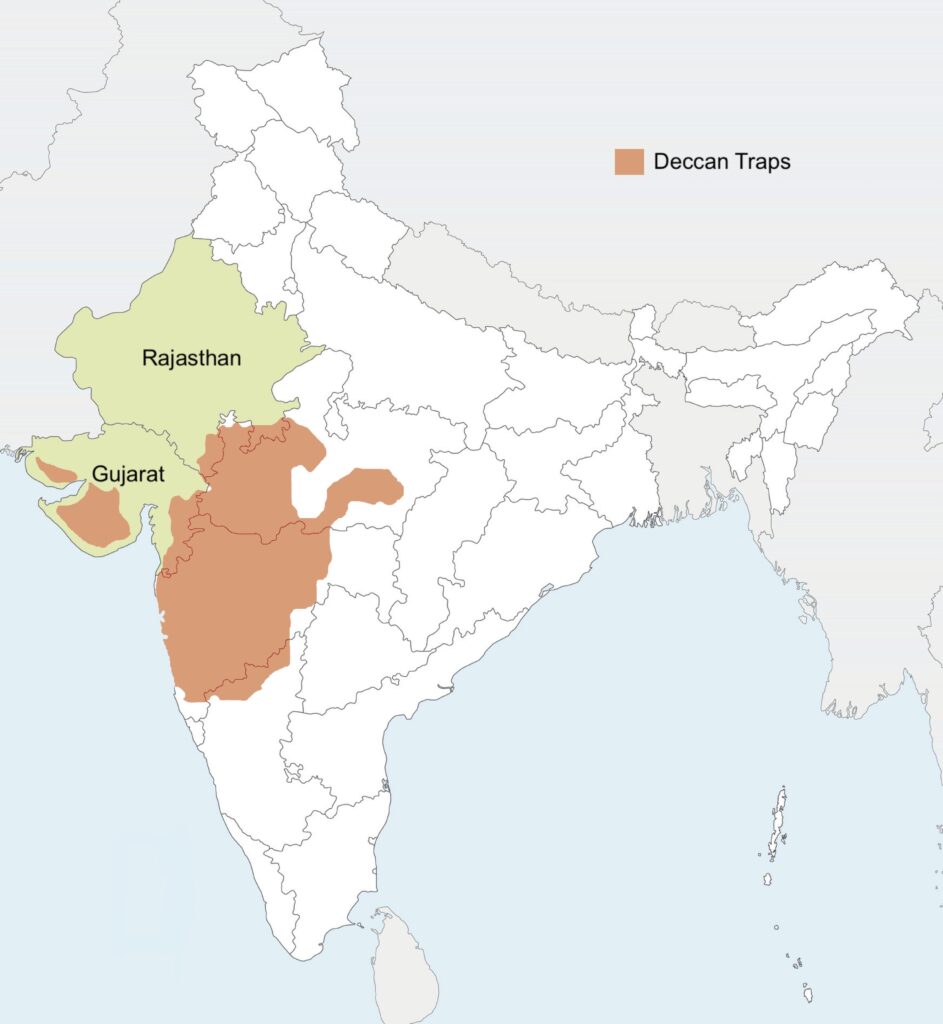Turning Invasive Plants into Agricultural Assets: Inside ISAP India’s Biochar Vision
A dense thicket of mesquite taking over pasture and agricultural land
When Mesquite (Prosopis juliflora) was introduced to the south Indian state of Tamil Nadu in 1877, it was regarded as a useful plant, by all accounts. Its quick-growing nature made it well-suited for use as firewood, as well as a natural barrier for corralling livestock and mitigating desertification.
Before long, however, the plant proved difficult to manage and quickly took over the area. Today, it is found in nearly every state in India. Its thorns and low branches form impenetrable thickets that compete with native vegetation, disrupt ecosystem functioning, and block cattle from reaching watering holes and pastures. Mesquite’s deep roots deplete the soil of nutrients and groundwater, and its dense growth crowds out native species, reducing habitat diversity and resulting in a loss of vital food sources.
Mesquite’s long thorns prevent livestock from easily eating the leaves and seed pods. Yet, the animals that do eat them face poisoning by the seed pods, which contain alkaloids that are neurotoxic when consumed in large amounts. Also, mesquite’s ability to regenerate from the roots makes removal challenging. Other countries affected by this invasive plant consider it a noxious invader and have implemented removal strategies of their own.
In July 2022, the Indian state of Tamil Nadu unveiled a policy to eliminate the invasive species. The Indian Society of Agribusiness Professionals (ISAP India) responded by unveiling a groundbreaking approach to eliminate the invasive species while simultaneously promoting sustainable agriculture in India. ISAP India supports small farms across India, where approximately 85% of land is owned by small and marginal farmers. ISAP India conducts outreach programs for smallholdings to improve access to agricultural knowledge and technology. Since 2001, ISAP India has launched numerous projects to enhance the livelihoods of rural communities. With a vast network spanning 23 states, ISAP India has connected tens of thousands of small-scale farmers with opportunities to boost agricultural productivity, adopt environmentally friendly practices, and create local employment opportunities. In line with its focus on sustainable agriculture, ISAP India is currently taking steps to transform invasive mesquite into a carbon negative soil amendment called biochar.
Biochar as a solution
Biochar is a material originally developed by the indigenous peoples of the Amazon Basin to enhance soil fertility. While it resembles charcoal, there are key differences between the two. Biochar is produced through pyrolysis, a process in which organic materials like wood chips, agricultural byproducts, or invasive species are heated with minimal or no oxygen. This method preserves the carbon structure and nutrients, making biochar highly beneficial for soil. In contrast, charcoal is produced at higher temperatures with oxygen, mainly from wood, and is designed for use as fuel or in cooking rather than for enhancing soil. Unlike traditional charcoal, biochar is meant to be buried, providing both agronomic and environmental benefits.
When soil is compacted by tillage or plowing, it becomes less effective at absorbing water and gasses. Biochar enhances soil health by improving its structure, making it more functional and resilient. The porous nature of biochar allows it to act like a sponge, supporting microorganisms, enhancing aeration, boosting water retention, and retaining essential nutrients, thereby reducing the need for chemical fertilizers, which are often derived from fossil fuels.
Biochar’s ability to enhance crop yields and agricultural productivity makes it a valuable asset in areas with depleted soils, limited resources, or water scarcity. Furthermore, its durability against chemical and microbial degradation ensures that the benefits last for decades or even centuries. Beyond its agricultural uses, biochar also contributes to environmental health by absorbing heavy metals and purifying water.
Moreover, buried biochar has the ability to store carbon in a stable form, effectively reducing CO2 levels in the atmosphere and helping to combat climate change. The process of pyrolysis, integral to creating biochar, converts decaying organic matter, which otherwise emits CO2, into a carbon-negative substance. Agriculture fixes about 30 gigatons of carbon each year, but returns it to the atmosphere as plants die, resulting in minimal net change. By adding biochar, CO2 is sequestered in the soil in a stable form, interrupting this cycle and results in a lasting reduction in atmospheric CO2 levels. Using biochar as a soil amendment represents a significant pathway to slowing global warming. By enhancing soil quality and promoting plant growth, biochar supports food security and environmental stewardship, embodying a forward-thinking approach to both agriculture and climate change mitigation.

We’ve basically made money from degenerating the environment… by extracting and running these ecosystems down and not caring about the future. We’re calling for the opposite of that… and this soil up strategy gets to the roots.
Thomas J. Goreau, PhD
Exploring innovative solutions like biochar is essential to combat the ecological challenges posed by invasive mesquite. ISAP India’s biochar project is focused in Rajasthan and Gujarat, where nearly 4 million hectares of land have been overtaken by mesquite. The initiative seeks to tackle the ecological and economic challenges posed by this invasive species while also supporting agricultural practices and climate mitigation efforts.
Tom Goreau is a biochar expert and a Board Director of Remineralize the Earth (RTE), whose advisory work with ISAP India includes addressing concerns about biochar production competing with agricultural land.
“There are huge opportunities to transform land that has been degraded to the point of uselessness and make it productive again,” Goreau said, noting that Mesquite was chosen deliberately to avoid the issue of repurposing agricultural land solely for biochar production. “This project never advocated planting crops solely to burn them for biochar.”
Mesquite: From problem to solution
Mesquite, with its dense, spiny thickets, has turned vast areas of Gujarat into mono-species forests, rendering the land unsuitable for farming or grazing. Choosing mesquite as the primary material for biochar allows for the removal of this invasive species, enabling the restoration of the land for agricultural use.
This approach results in increased biomass, enhanced biodiversity, restored ecosystem functions, and simultaneous regeneration through improved carbon storage. Using invasive species for biochar production not only controls them, but also converts previously unproductive land into pastures for livestock and agriculture, and minimizes competition with food crops. All while offering a sustainable solution for land management.
Starting from the roots up, the removal of Mesquite biomass involves local communities in reclaiming land that was previously overgrown and unusable. Removing mesquite creates jobs for locals and restores land to productive agricultural use for farmers.
Mesquite cleared from the land is placed in a combustion kiln on site. Instead of being burned to ash, this biomass undergoes pyrolysis, resulting in the production of biochar. High quality biochar is typically produced at high temperatures to “ensure that the biochar lasts longer and remains effective as a carbon sink,” Goreau explained.
ISAP India is currently focused on advancing kiln technology at biochar sites in Gujarat and Rajasthan. Previous trials utilized Kontiki kilns, which produced about 1,000 tons of biochar since the project’s inception in December. Although open kiln systems are cost-effective, they produce lower-quality biochar with reduced carbon storage longevity. Additionally, open kilns lose heat and gas energy produced during pyrolysis, which could be repurposed for domestic uses such as heating and cooking, which would offer added functionality for households located near the site. Moreover, operating kilns to produce biochar close to the source of the mesquite helps reduce transportation costs, minimizing expenses and environmental impacts. ISAP India is currently working on enhancing various aspects of the project, such as increasing kiln efficiency, improving biochar quality, and making use of byproducts produced in open kiln designs.
However, while biochar provides a myriad of agronomic and environmental co-benefits, Goreau explained that “biochar alone is not a complete solution” to restore agricultural soil to its desired level of regeneration, as it in itself is not a fertilizer.
Because soils are deficient in one element or another, and in some cases almost all, a nutrient supplement is needed to provide the soil with the elements that plants need. For example, the limestone soils that Goreau works with in the Maldives consisted of mostly calcium carbonate but lacked in all other nutrients, making it necessary to supplement soils with fertilizers.
“Most soils have serious nutrient limitations,” Goreau explained. Chemical fertilizers typically focus on nitrogen, phosphorus, and potassium but fail to provide the full spectrum of nutrients plants need. This imbalance can lead to nutrient deficiencies and environmental pollution, in a scenario where plants are unable to fully utilize the nitrogen, phosphate, and potassium due to a lack of essential trace elements, resulting in most of the chemical fertilizer being simply flushed into bodies of water and polluting the ecosystems downstream.
Providing nutrients with biochar and rock dust
A long-term goal for the project would be to combine the biochar produced from mesquite with basaltic rock dust. In collaboration with members of the Indian Geological Survey, RTE is working on a concept to incorporate basalt into the biochar to create a more effective mixture. ISAP India’s biochar project in Gujarat and Rajasthan is in close proximity to some of the best sources of basalt in the world. Located in western India, the Deccan Traps is a vast, rugged plateau formed by solidified lava. This extensive igneous province spans west-central India and ranks among the largest volcanic features on Earth, characterized by layers of solidified flood basalt up to 2,000 meters thick, covering an area of more than 500,000 square kilometers.
This abundant source of basalt highlights India’s exceptional potential for rock dust applications. A substantial portion of this basalt is found in Gujarat, while Rajasthan borders another extensive part of the formation. The proximity of this basalt resource lowers transportation costs, making it an easily accessible material for the project. Furthermore, since the Deccan Traps extends along the western coast of India, there is potential to use basaltic rock dust in future projects beyond Gujarat and Rajasthan.
Basaltic rock dust is an effective alternative to chemical fertilizers when used with biochar. This finely ground powder, derived from selected rock sources, provides a balanced mix of essential elements for plant growth. This process replicates the natural breakdown of sediment found in rivers, glacial moraines, alluvial fans, and other sedimentary environments. As various rock types dissolve, they release a range of minerals, each providing unique elements. Basalt is particularly notable for its rich mineral content and alkaline properties, making it an excellent source of essential nutrients.
“Biochar needs to be combined with compost and rock dust to provide a comprehensive nutrient profile,” Goreau explained. He emphasized that while biochar improves soil structure, its benefits are significantly enhanced when combined with basalt, which acts as a slow-release fertilizer, addressing nutrient deficiencies often overlooked by chemical fertilizers and reducing the need for frequent reapplications, thus offering a more sustainable option that minimizes environmental pollution.
There is a variety of research that has already examined the effectiveness of rock dust as an alternative fertilizer. One such project was conducted by Goreau on a basalt Quarry in Panama in 2011. The research focused on Acacia Mangium seedlings, which were planted in three different soil conditions: local non-arable soil, basalt outcrop, and a layer of basalt rock dust. Over a five-year period, seedlings in basalt rock dust experienced an eightfold increase in biomass, more than doubling in height, and with four times better survivability compared to those planted in local soil, which did not survive. The trees in basalt-treated soils also showed thicker trunks, more abundant and larger leaves, and improved nutritional value. This study demonstrated that basalt rock dust functions as a slow-release fertilizer, providing essential minerals and acting as a carbon sink. Goreau also proposed that combining basalt rock dust with biochar could amplify these benefits. He recommended conducting a large-scale study to optimize the use of rock powders, various plant species, and soil types to achieve even better results in agricultural and environmental restoration efforts.
Hope for Indian agriculture
By undertaking projects that improve soil quality and restore agricultural land, India could increase domestic food production and rely less on imported food. Enhancing soil fertility would enable the country to better support its large population and reduce its dependence on external food sources. Establishing local biochar sources would also reduce reliance on imported chemical fertilizers, insulating farmers from the volatility of global fertilizer prices.

Goreau is particularly keen to develop locally-sourced biochar and rock dust, noting that “local sources are key to ending the dependence on chemical fertilizers anywhere.”
Converting mesquite into biochar holds great potential, especially when paired with basalt rock dust. By prioritizing local production, leveraging innovative technologies, and integrating biochar with compost and rock dust, the ISAP India project aims to enhance soil fertility, manage invasive species, reduce greenhouse gasses, and advance sustainable agriculture. This project is a practical and effective example of ecosystem restoration and agricultural resilience. The integration of biochar with basalt rock dust not only promises a sustainable path for improving soil health and agricultural productivity but also provides a model for addressing ecological challenges globally.
There is significant global potential for other projects similar to ISAP India’s biochar initiative. This method is not confined to specific regions but can be applied worldwide to regenerate soils, manage invasive species, and promote sustainable land use. Invasive species are a common challenge across various regions, causing significant economic damage and environmental degradation. By converting these invasive species into biochar, a global liability can be transformed into a productive resource. This approach not only mitigates the negative impact of invasive species but also enhances land productivity, biodiversity, and economic value. This initiative not only represents a forward-thinking approach to land management but also sets a benchmark for similar projects worldwide, demonstrating how innovative solutions can inspire and drive change across diverse regions.
Anna Himelstein is a graduate in Geology and GIS from West Virginia University. For the past two years she has been solo traveling across many countries. Her route has taken her to India, Nepal, Sri Lanka, Egypt, Jordan, Mexico, Georgia, Eastern Europe, and many more. Along the way she volunteered for several organic farms, learning how people around the world approach agriculture and life. Inspired by the places she’s been and the knowledge of strong communities, she’s now returning to the United States with a drive to support local connection to agriculture, community, and the earth. Though her primary focus is on geological research, she is keen to learn from the various disciplines that contribute to sustainability and agriculture. She began as a science writer for Remineralize the Earth in 2024, inspired by the team’s natural approach to enriching agricultural soils. She’s also a ceramicist, with studio spaces in Utah and an artist residency in Austria.
Support us on Patreon
Thank you for joining us today! Please become a member of RTE and support us on Patreon. Unlike many larger organizations, we work with a team of determined and passionate volunteers to get our message out. We aim to continue to increase the awareness of remineralization to initiate projects across the globe that remineralize soils, grow nutrient dense food, regenerate our forests’ and stabilize the climate – with your help! If you can, please support us on a monthly basis from just $2, rest assured that you are making a big impact every single month in support of our mission. Thank you!











Got something to say?